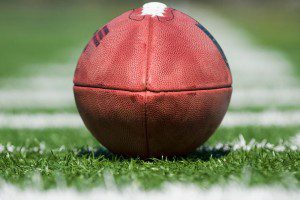News and Insights
The NIL revolution: the transformative impact of the NIL rights ruling in US college sport and the rise of the ‘student-athlete-influencer’
August 28, 2024
At 5pm on Saturday 24 August, 25,000 Americans descended on a sold-out Aviva Stadium to watch college football teams Georgia Tech versus Florida State, as part of the now annual Aer Lingus Classic. According to the organisers, this year’s fixture, alongside the week-long pageantry of tailgaters, cheerleaders, marching bands, and well-heeled alumni, will contribute €115 million to the Irish economy.
American college sport is big business. It is exponentially bigger, louder, and shinier than anything comparable in Europe. Yet, despite its omnipresence in the US, the sheer scale of its vast commercial and cultural footprint doesn’t always penetrate the public consciousness on this side of the Atlantic.
Division One college sport is a $16 billion industry, most of which is generated from football and men’s basketball. The two sports have recently signed new broadcasting deals worth $1.3 billion and $1.1 billion per year respectively. Women’s basketball is also having a moment in the sun. Its broadcasting rights has seen a tenfold increase in just four years to $65 million. Whilst theses domestic broadcasting deals are not quite hitting English Premier League numbers (£3.5 billion per year for global rights), they comfortably surpass nearly every other professional sports league in the world, with the exception of the NFL and NBA.
It’s not just a tv spectacle either. Eight of the ten largest football stadiums in the US are college stadiums, with University of Michigan’s Michigan Stadium sitting top of the pile with a capacity of 107,000.
Coaching these college teams can be a lucrative endeavour. Florida State head coach Mike Norvell earns an annual salary of $9.8 million, while Georgia Tech head coach Brent Key makes a comparatively modest $2.8 million, placing him near the bottom of the pay scale among his peers.
A civil rights issue, not just an economic one
Despite the enormous sums involved, historically, the star attractions – namely the athletes that fill these vast stadiums – have been sidelined whilst everyone else divides up the bountiful spoils.
Instead, these student-athletes have had to settle for a free education and the lottery-like hope that they may be one of the lucky two per cent that will one day graduate to the pro leagues.
This strictly amateur ethos has long been contentious. Critics have argued that colleges athletes, many of whom are African American or from disadvantaged backgrounds, were being unfairly denied the financial rewards generated by their talents. Some have framed it as a civil rights issue rather than an economic one, with ESPN basketball analyst Jay Bilas, amongst others, describing it as a ‘plantation mentality’.

A transformative moment
In March 2021, the National Collegiate Athletics Association (NCAA) reluctantly ceded some ground. The newly introduced Name, Image and Likeness (NIL) Rights ruling meant that players could now monetise their personal brands. Whilst the US colleges wouldn’t pay these student-athletes directly, they were free to secure their own commercial deals, and for example, monetise their social media followings.
For many, this represented a transformative moment, and a long overdue correction of an unfair system. For others, it signalled the unravelling of very integrity of college sport. Addressing a recent US Congressional hearing, legendary former college head coach Nick Saban, whose own college career earnings exceeded $150 million, spoke of his disillusionment with the NIL ruling, suggesting that all college athletes now “care about is how much you’re going to pay them.” In other words, student-athletes were at risk of being corrupted by the same financial opportunities their coaches have long since enjoyed.
Who stands to benefit?
In the first year of the NIL ruling, college athletes made $917 million, with paid-for social media activity accounting for 72% of the overall spend. Inevitably, some student-athletes have benefited more than others; those with the biggest platforms have most to gain, while those in less prominent varsity sports have had to be more creative to monetise their sporting excellence.
Some of the biggest NIL earners in 2023 were the next generation of revered sporting families, including USC’s Bronny James, son of LeBron, and University of QB Arch Manning – nephew of Peyton and Eli.
Typically, those who have been most successful in capitalising on these new opportunities are the student-athletes that can marry on-field excellence with off-the-field entrepreneurship. For example, LSU gymnast and prolific TikToker Olivia Dunne, and women’s basketball player and sometimes rapper Flau’jae Johnson.
Delayed professionalism
It has also given to a new dynamic, whereby in some scenarios, athletes in the traditional big three sports no longer feel the same urgency to make it to the pro leagues to cash in on their talent.
LSU basketball star Flau’jae Johnson’s NIL valuation is estimated to be worth $1.1 million. She already has deals with Powerade, Puma and Amazon, and her commercial potential, as the face of LSU basketball, will continue to rise into the new basketball season. Meanwhile, the median WNBA salary is $78,000. In crude marketing terms, it may be more profitable to be the star player in women’s college basketball, than a rookie bench option in the WNBA.
Like any change of this scale, it hasn’t all been plain sailing. The unregulated nature of NIL deals, much of it playing out on social media, have given rise to concerns of fairness, transparency, and the potential for exploitation.
However, the NIL ruling, and the subsequent expansion of the NCAA player transfer portal, aligns with the broader cultural shift toward greater athlete empowerment. For many younger sports fans, their unstinting loyalty is to their favourite athletes rather than their favourite teams. This is borne out by the social media followings of individual athletes versus the teams they represent. The NIL rights ruling has now liberated student-athletes to monetise this new power dynamic.
On the eve of Florida State departing Tallahassee for Dublin, starting quarterback and Beats by Dre ambassador DJ Uiagalelei took to Instagram to gift the entire football squad personalised Beats by Dre headphones. The traditionalists may wince, but it is the just another example of the brave new dawn of the student-athlete-influencer.
This article was originally published on Sunday 25 August in the Sunday Independent.
